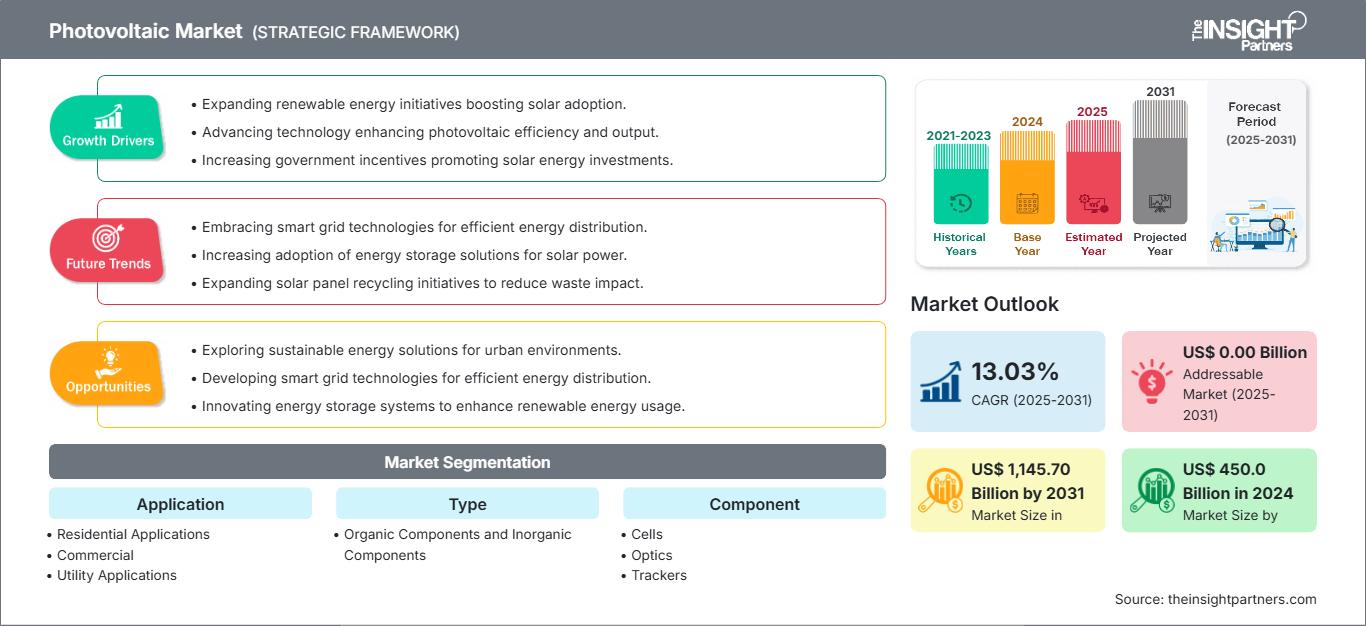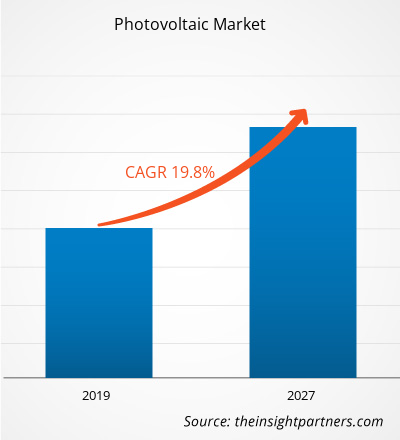태양광 시장 규모는 2024년 4,500억 달러에서 2031년 1조 1,457억 달러로 성장할 것으로 예상됩니다. 2025년부터 2031년까지 연평균 성장률 13.03%를 기록할 것으로 예상됩니다.
기술 개발과 태양광 기술 성장 추세에 대한 집중에 따라, 독일과 스페인 정부는 명확한 국가 목표, 소비 촉진을 위한 매력적인 인센티브, 그리고 태양광 에너지 기술 개발 및 태양광 기술 도입을 촉진하기 위한 통합 계획 등 탄탄한 정책 체계를 수립하여 태양광 시장 성장을 견인하고 있습니다. 아시아 태평양 지역에서는 정부가 농촌 지역 전력 공급에 있어 오프그리드 옵션의 광범위한 이점을 극대화하기 위해 전반적인 설치 비용을 최소화하고 지속 가능한 환경 조건에 대한 관심을 높이기 위한 여러 가지 이니셔티브를 시행하고 있습니다. 또한 중국을 비롯한 여러 국가에서 태양광 발전 에너지 생산 수준을 높이기 위한 정책을 수립했습니다. 따라서 위에서 언급한 요인들이 태양광 시장 성장에 기여하고 있습니다. 태양광(PV) 에너지는 경제 전력 시스템의 에너지 균형에 상당한 기여를 하며 빠르게 성장하고 있습니다. 이러한 시스템은 주류 전력 생산에 사용되는 성숙한 기술로 자리 잡았으며 태양광 시장 성장을 견인하고 있습니다. 그러나 태양광 PV 시스템은 과도한 전기를 생산합니다. 전 세계 전력 공급업체는 계통 연계형 재생에너지 시스템에서 생산된 잉여 전기를 전기 계량기로 반환하는 방식인 순계량제를 시행하고 있습니다. 이를 통해 에너지 낭비를 방지하고 필요에 따라 에너지 분배를 개선할 수 있습니다. 계통 연계형 PV 시스템은 배터리를 필요로 하는 독립형 시스템에 비해 설비 용량의 약 99%를 차지합니다. 배터리가 필요 없는 계통 연계형 PV는 비용 효율적인 솔루션으로 여겨지고 유지 보수가 덜 필요하기 때문에 PV 기반 제품의 도입률이 높아지고 태양광 시장 점유율이 확대되고 있습니다.
또한, 태양광 패널로 전환하는 사람들에게 계통 연계형 PV 시스템은 전체 전기 수요를 충족하는 비용 효율적인 옵션으로 여겨집니다. 독립형 시스템 설치는 상당히 까다롭고 PV 계통 연계형 시스템보다 더 많은 자본과 공간이 필요합니다. 따라서 PV 계통 연계형 시스템 도입 증가는 태양광 시장 성장을 더욱 촉진할 것입니다. 더 나아가, 재생에너지 사용에 대한 관심이 높아지고 에너지 절약 추세가 확산됨에 따라 계통 연계형 PV 시스템은 경제적으로 실현 가능한 옵션으로 입증되고 있습니다. 그러나 현재로서는 적용 범위가 제한적이며 향후 몇 년 안에 증가할 가능성이 있습니다.
이 보고서의 일부, 국가 수준 분석, Excel 데이터 팩을 포함하여 모든 보고서에 대한 사용자 정의를 무료로 받을 수 있을 뿐만 아니라 스타트업 및 대학을 위한 훌륭한 제안 및 할인을 이용할 수 있습니다
태양광 시장: 전략적 통찰력

-
이 보고서의 주요 주요 시장 동향을 확인하세요.이 무료 샘플에는 시장 동향부터 추정 및 예측에 이르기까지 데이터 분석이 포함됩니다.
태양광 시장 분석: 태양 에너지 활용을 위한 태양광 페인트 사용 증가
원유 가격 변동성, 수력 발전 관련 환경 문제, 그리고 원자력 방사능 관련 위험은 태양 에너지 수요 충족의 부담을 증가시켰습니다. 기술 발전, 설치 비용 절감에 대한 집중, 그리고 주거용 태양광 기술의 빠른 활용은 태양광 기술의 활용 방식을 재정의하는 요인 중 하나입니다. 태양 에너지 사용이 증가하는 시대에, 태양광 페인트의 도입은 놀라운 성과를 이루었습니다. 태양광 페인트, 또는 흔히 태양광 페인트라고 불리는 이 페인트는 어떤 표면에든 도포하여 태양 에너지를 포집하고 전기로 변환할 수 있습니다. 페인트의 구성 요소는 수십억 개의 감광성 물질과 결합되어 일반 페인트를 초강력 에너지 포집 페인트로 탈바꿈시키는 데 도움이 될 수 있습니다. 태양광 페인트를 사용하면 금속 의존도를 낮추고, pn 접합 다이오드 원리와 열전 효과를 결합하여 태양광 노출로부터 전기 에너지를 생산할 수 있습니다. 따라서 이는 태양 에너지 도입 증가로 이어지고 궁극적으로 태양광 시장 성장을 촉진할 것입니다. Onyx Solar Group LLC와 같은 기업들은 R&D 활동에 집중하고 관련 연구소와 협력하여 태양광 페인트를 개발하고 태양광 시장 성장을 견인하는 기술 개발을 목표로 하고 있습니다. 태양광 페인트 또는 태양광 페인트 기술은 현재 초기 단계에 있지만, 가까운 미래에 주목을 받을 것으로 예상됩니다. 태양광 산업의 발전과 함께 태양광 페인트는 합리적인 선택지가 될 수 있는 좋은 기회를 가지고 있습니다. 따라서 위에서 언급한 요소들이 태양광 시장에 기회를 창출하고 있습니다.
태양광 시장 지역별 통찰력
The Insight Partners의 분석가들은 예측 기간 동안 태양광 시장에 영향을 미치는 지역별 동향과 요인들을 면밀히 분석했습니다. 이 섹션에서는 북미, 유럽, 아시아 태평양, 중동 및 아프리카, 그리고 중남미 지역의 태양광 시장 부문과 지역별 분포도 살펴봅니다.
태양광 시장 보고서 범위
| 보고서 속성 | 세부 |
|---|---|
| 시장 규모 | US$ 1,145.70 Billion by 2031 |
| 시장규모별 | US$ 450.0 Billion in 2024 |
| 글로벌 CAGR (2025 - 2031) | 13.03% |
| 이전 데이터 | 2021-2023 |
| 예측 기간 | 2025-2031 |
| 다루는 세그먼트 |
By 응용 프로그램
|
| 포함된 지역 및 국가 |
북미
|
| 시장 선도 기업 및 주요 회사 프로필 |
|
태양광 시장 참여자 밀도: 비즈니스 역학에 미치는 영향 이해
태양광 시장은 소비자 선호도 변화, 기술 발전, 그리고 제품 이점에 대한 인식 제고 등의 요인으로 인한 최종 사용자 수요 증가에 힘입어 빠르게 성장하고 있습니다. 수요가 증가함에 따라 기업들은 제품 라인업을 확장하고, 소비자 니즈를 충족하기 위한 혁신을 추진하며, 새로운 트렌드를 적극 활용하고 있으며, 이는 시장 성장을 더욱 가속화하고 있습니다.

- 을 얻으세요 태양광 시장 주요 주요 플레이어 개요
부품 기반 시장 분석
태양광 전지는 두 개 이상의 얇은 반도체 물질층으로 구성됩니다. 태양 전지에 가장 일반적으로 사용되는 물질은 실리콘입니다. 반도체 셀은 빛에 노출되어 전하를 생성하며, 이 전하는 금속 접촉을 통해 직류(DC)로 전달될 수 있습니다. 따라서 PV 셀 도입 증가는 예측 기간 동안 세계 태양광 시장 규모를 증가시킬 것입니다.
태양광 시장 참여 기업들은 합병, 인수 및 시장 주도권 확보와 같은 전략을 통해 태양광 시장에서의 입지를 유지하고 있습니다. 주요 기업들의 몇 가지 개발 사례는 다음과 같습니다.
- 2021년 Royal Dutch Shell PLC는 25MW 규모의 Qabas 태양광 시설을 처음 선보였습니다. 이 프로젝트는 88,000개 이상의 태양광 모듈로 구성되었으며, 오만 북부 소하르 자유무역지구의 50헥타르 부지에 건설되었습니다. 이는 연간 약 25,000톤의 이산화탄소 배출량 감축에 기여합니다.
- 2021년, ACWA Power는 12억 사우디 리얄(약 1조 2,000억 원)을 투자하여 국내 최초의 유틸리티 규모 재생에너지 프로젝트인 300MW 규모의 사카카 태양광 발전(Sakaka PV IPP)을 준공했습니다. ACWA Power는 kWh당 2.3417센트(kWh당 8.781할랄라)라는 세계 최고 수준의 요금으로 이 프로젝트를 수주했습니다.
- 과거 분석(2년), 기준 연도, CAGR을 포함한 예측(7년)
- PEST 및 SWOT 분석
- 시장 규모 가치/거래량 - 글로벌, 지역, 국가
- 산업 및 경쟁 환경
- Excel 데이터세트
최근 보고서
사용 후기
구매 이유
- 정보에 기반한 의사 결정
- 시장 역학 이해
- 경쟁 분석
- 고객 인사이트
- 시장 예측
- 위험 완화
- 전략 기획
- 투자 타당성 분석
- 신흥 시장 파악
- 마케팅 전략 강화
- 운영 효율성 향상
- 규제 동향에 발맞춰 대응






















 무료 샘플 받기 - 태양광 시장
무료 샘플 받기 - 태양광 시장